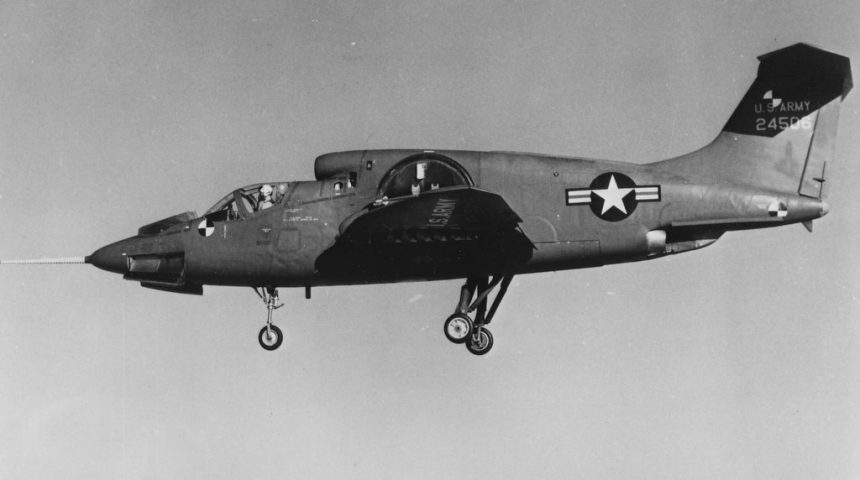Obscure XV-5A Vertifan Was The “Mistake” That Preceded Tiltrotors Like Osprey.
It was a gateway design to both the F-35B STOVL (Short Take-Off and Verical Landing) variant and the V-22 Osprey tiltrotor. Its performance was incredibly impressive, especially for 1966. With a top speed of 546 MPH, 1,000-mile range and a lifting cable for rescuing a downed pilot, it was a novel concept that bridged the gap between high performance jets and rescue helicopters of the era.
And it had a ruthless appetite for killing test pilots in the golden age of flight testing. OTD in 1966 Maj. Dave Tittle died when the XV-5A crashed during a rescue recovery test at Edwards AFB, California. He was one of two pilots killed in the XV-5A, with a third pilot surviving an ejection from the aircraft before the program was cancelled.
The Ryan XV-5A Vertifan was a fascinating experimental jet aircraft that used a pair of novel lift fans installed in the wings to transition between and maintain vertical flight from horizontal flight. It could hover, fly backwards and operate from unprepared landing areas. When Ryan installed a small door in the side of the aircraft for recovering a rescue victim, an entirely new category of military aircraft was born; a jet that could hover to pick up a downed airman and fly at the same speed as other jet strike aircraft. This capability provided jet strike packages with an organic search and rescue capability.
But mixing capabilities also has a tendency to create angry squabbles between military branches. The XV-5A program “belonged” to the Army because the aircraft could hover. But the XV-5A was almost heavy enough to exceed a bizarre contract ordinance restricting the overall weight of aircraft operated by the U.S. Army to 5,000 pounds. This restriction maintained parochial authority of large aircraft for the U.S. Air Force, Navy and Marines, branches that were interested in keeping the Army out of the flying business and its attendant generous funding.
Author George J. Marrett, veteran test pilot and combat veteran of 188 missions over Vietnam in the A-1 Skyraider, wrote a fascinating chapter in his book, Contrails Over the Mojave: The Golden Age of Flight Testing at Edwards Air Force Base (2008, Naval Institute Press) about the XV-5A Vertifan.
Marrett wrote that, “The XV-5A Vertifan was designed and built for the Army’s Transportation Research Command by Ryan Aeronautical Company, San Diego, in conjunction with General Electric, developers of the aircraft’s lift-fan propulsion system. The Army believed that VTOL aircraft could make a major contribution to the mobility needed for limited warfare. The XV-5A would be used for surveillance of the battlefield and rescue of downed aircrew. Freed from dependence on airfields, the Vertifan blended the flexibility of the helicopter with the performance of a jet.”
While the XV-5A was an outstanding melding of flight characteristics on its way to creating two new categories of aircraft with unique capabilities, it was also a stretch for the flight control and ergonomics of the era. And it was that stretch that cost the life of Maj. Dave Tittle.
According to accounts of Maj. Dave Tittle’s fatal XV-5A crash, a test rescue cable was lowered from the aircraft at about 50-feet. In video of the incident, the cable can be seen undulating wildly under the plane, whipping around in the wind and from the movement of the XV-5A as it slowly hovers forward over the tarmac. A test volunteer rescue victim on the ground briefly attached a horse-collar style rescue harness, climbed into it, and was successfully hoisted a few feet into the air by the XV-5A with Tittle at the controls. As Author George J. Marrett wrote in his book, “The XV-5A was in a slight forward moving turn while raising the sling.”
The cable somehow managed to whip up into the left-wing fan inlet for the vertical thrust outlet. This either reduced or eliminated thrust from the left wing, causing the aircraft to begin to roll to the left. The XV-5A also began a descent that appears controlled in film of the accident.
An instant prior to the aircraft’s left wheel impacted the tarmac, Maj. Dave Tittle had initiated the ejection sequence. As his ejection seat traveled up its rails, the roll attitude of the aircraft changed from wings level to rolled left, instantly altering the trajectory of Tittle’s ejection seat. He went from a possibly survivable vertical ejection trajectory to an unsurvivable, nearly horizontal ejection attitude.
Video shows his seat rocketing out of the aircraft as the parachute begins to deploy, but never fully opens as the seat arcs into the ground. Sadly, Major Dave Tittle died soon after in the Edwards Air Force Base hospital.
In memory of Major Dave Tittle’s remarkable flight testing career, the Test Pilot School at Edwards Air Force Base created the Liethen-Tittle Award for academic and flight test excellence. The award honors the legacy of Maj. Dave Tittle and Major Frank Liethen Jr., who died on October 12, 1966, along with Capt. Robert Morgan, in a collision of two USAF Thunderbird F-100 Super Sabres.
While the XV-5A program can be fairly characterized as a failure in terms of this specific aircraft, its overall influence on future programs was profound, and clearly influenced aircraft design and capabilities to this day, over a half-century later.
The program solidified the need for a vertical life asset for Search and Rescue as well as a (relatively) high speed, longer range STOVL aircraft: for this reason the project is considered to have reinforced the relevance and feasibility of a longer-range, V/STOL platform like the V-22 Osprey too.









